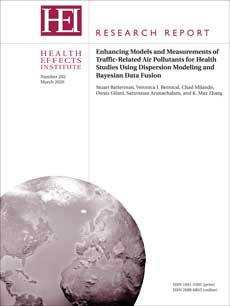You are here
Study compares statistical models for use in exposure assessment
 HEI has published Research Report 202, Enhancing Models and Measurements of Traffic-Related Air Pollutants for Health Studies Using Dispersion Modeling and Bayesian Data Fusion, which describes a study led by Dr. Stuart Batterman at the University of Michigan, Ann Arbor and colleagues. The investigators evaluated the ability to predict traffic-related air pollution using a variety of methods and models, including a line source air pollution dispersion model and sophisticated spatiotemporal Bayesian data fusion methods. Exposure assessment for traffic-related air pollution is challenging because the pollutants are a complex mixture and vary greatly over space and time. Because extensive direct monitoring is difficult and expensive, a number of modeling approaches have been developed, but each model has its own limitations and errors.
HEI has published Research Report 202, Enhancing Models and Measurements of Traffic-Related Air Pollutants for Health Studies Using Dispersion Modeling and Bayesian Data Fusion, which describes a study led by Dr. Stuart Batterman at the University of Michigan, Ann Arbor and colleagues. The investigators evaluated the ability to predict traffic-related air pollution using a variety of methods and models, including a line source air pollution dispersion model and sophisticated spatiotemporal Bayesian data fusion methods. Exposure assessment for traffic-related air pollution is challenging because the pollutants are a complex mixture and vary greatly over space and time. Because extensive direct monitoring is difficult and expensive, a number of modeling approaches have been developed, but each model has its own limitations and errors.
Dr. Batterman and colleagues sought to improve model estimations by applying and systematically comparing the performance of different statistical models. The study made extensive use of data collected in the Near-road EXposures and effects of Urban air pollutants Study (NEXUS), a cohort study designed to examine the relationship between near-roadway pollutant exposures and respiratory outcomes in children with asthma who live close to major roadways in Detroit, Michigan.


